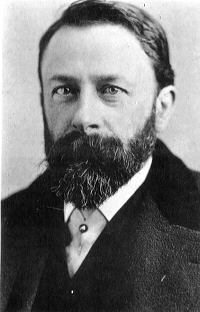Albert Bierstadt (Albert Bierstadt)

Artist. He is best remembered for his lavish, sweeping landscapes of the American West. His exhibition pieces were brilliantly crafted images that glorified the American West as a land of promise. Born in Solingen, Rhine Province, Prussia (now Germany), he immigrated with his family to New Bedford, Massachusetts in 1831. He became interested in art at an early age, making crayon sketches in his youth. In 1851 he began painting in oils and in 1853 he returned to Germany, studying painting for several years in Düsseldorf with members of its informal school of painting. In 1857 he returned to New Bedford and taught drawing and painting briefly, before devoting himself full-time to painting. In 1858 he exhibited a large painting of a Swiss landscape at the National Academy of Design, which gained him positive critical reception and honorary membership in the Academy. At this time he began painting scenes in New England and upstate New York, including in the Hudson River valley. A group of artists known as the Hudson River School portrayed its majestic landscapes and craggy areas, as well as the light affected by the changing waters. In 1859 he traveled westward with Frederick W. Lander, a land surveyor for the US government, to sketch those landscapes. After returning to his studio in New York, he turned his sketches into in numerous finished paintings. In 1863 he traveled west again with author Fitz Hugh Ludlow to do additional sketches and converted them into other large-scale paintings for exhibition. During the American Civil War he paid for a substitute to serve in his place when he was drafted in 1863. He completed one Civil War painting, “Guerrilla Warfare, Civil War” in 1862, based on his brief experiences with soldiers stationed at Camp Cameron in 1861. In 1860 he was elected a member of the National Academy. He received medals in Austria, Bavaria, Belgium, and Germany for his artwork. In 1867 he traveled to London, England where he exhibited two landscape paintings in a private reception with Queen Victoria. He traveled through Europe for two years, cultivating social and business contacts to sustain the market for his work overseas. A trip to the Yellowstone region in 1871 yielded numerous drawings of the area’s geysers and picturesque topography and his works were instrumental in convincing the US Congress to pass the Yellowstone Park Bill in 1872, thus establishing the first national park in the world. As a result of the publicity generated by his Yellowstone paintings, his presence was requested by every explorer considering a westward expedition, and he was commissioned by the Atchison, Topeka, and Santa Fe Railroad to visit the Grand Canyon for further subject matter. Despite his popular success, he was criticized by some contemporaries for the romanticism evident in his choices of subject and his use of light was felt to be excessive. In 1876 his wife was diagnosed with tuberculosis and from then until her death in 1893, he spent time with her in the warmer climate of Nassau in the Bahamas. He also continued to travel to the American West and Canada. In later life, his work fell increasingly out of critical favor and was often attacked for its theatrical tone. In 1882 his studio at Irvington, New York, was destroyed by fire, resulting in the loss of many of his paintings. By the time of his death at the age of 72, the taste for epic landscape painting had long since subsided. Among his notable paintings include “The Rocky Mountains, Lander’s Peak” (1863), “Looking Down Yosemite Valley” (1865), “Staubbach Falls, Near Lauterbrunnen, Switzerland” (1865), “Among the Sierra Nevada Mountains, California” (1868), “Yosemite Valley, Yosemite Park” (1868), “Lake Tahoe” (1868), “Rocky Mountain Landscape” (1869), “Storm in the Mountains” (1870), “Sierra Nevada” (1871 to 1873), “California Spring” (1875), “Mount Corcoran” (1876 to 1877), “The Last of the Buffalo’ (1888), and “Alaskan Coastal Range” (1889). Mount Bierstadt and Bierstadt Lake in Colorado are named in his honor. In 1998 the US Postal Service issued a set of 20 commemorative stamps entitled “Four Centuries of American Art,” one of which featured his “The Last of the Buffalo.” In 2008 the US Postal Service issued a commemorative stamp in its “American Treasures” series that featured his painting “Valley of the Yosemite” (1864). (bio by: William Bjornstad) Family links: Parents: Henry Bierstadt (1785 – 1866) Christiana M. Tilmans Bierstadt (1792 – 1864) Siblings: Charles Bierstadt (1819 – 1903)* Helen Bierstadt Thompson (1822 – 1905)* Edward Bierstadt (1824 – 1906)* Albert Bierstadt (1830 – 1902) Eliza Bierstadt (1833 – 1896)* *Calculated relationship
Born
- January, 07, 1830
- Germany
Died
- February, 02, 1902
- USA
Cemetery
- Rural Cemetery
- Massachusetts
- USA

